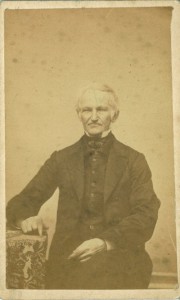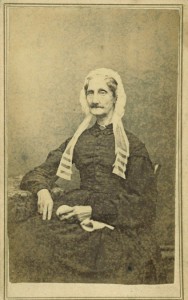
The names my parents ended up giving their children – Christopher, Carolyn, and Katherine – are names that most people would probably consider not that unusual. But there were several other names my father had in mind. For a boy, he liked the name Asa, in honor of his great-great-grandfather Asa Thurston Child (1820–1860). For my sisters he liked the names Tryphena and Tryphosa, after even more removed relatives of whom I was unaware in my youth. These names are biblical, mentioned by Paul in Romans 16: 11: “Salute Tryphena and Tryphosa, who labour in the Lord,” and in my experience in genealogy they have often been given to female twins.
I find two Tryphenas in the family. Mother and daughter, the elder was Tryphena Eaton (1768–1849), daughter of Nathaniel and Sarah (Johnson) Eaton, who lived in Woodstock, Ashford, and Mansfield, Connecticut. Tryphena Eaton’s birth is not recorded, so I do not know if she had a twin sister named Tryphosa who died young. Tryphena Eaton married Eli Kendall of Ashford and had several children, including twin daughters in 1803 – Tryphena and Tryphosa Kendall.
Tryphena Kendall married Moses Lyon (1793–1865) of Woodstock, who had a series of wives in a relatively short period of time. Moses and Tryphena had four children: Roxanna in 1823 (my great-great-great-grandmother, who married Asa T. Child, above); Mary Elizabeth in 1826 (who died three days later); and a second generation of twins – a boy and girl in 1828, both of whom died the same day. Tryphena herself died only two weeks after delivering the twins and Moses was a 34-year-old widower with a four-year-old daughter.
Moses married for the second time three years later to Sally May. They had a daughter, Sarah Tryphena Lyon, in 1831, her middle name given in honor of Moses’s late wife. While the daughter Sarah survived, Moses’s young second wife Sally died three months after Sarah’s birth. Now 37, Moses Lyon was a widower for the second time, with two daughters aged 7 and three months.
Moses married for the third time a little less than two years later in 1833 to Sally’s sister Dolly May. While they had no children, this marriage was also short-lived, lasting for five years and seven months – at this point his longest marriage – as Dorothy died in 1838 at age 39. Moses, now 45, was a widower again for the third time, still with two daughters, now 15 and 7.

Moses married for the fourth and final time eighteen months later in 1840 to Sarah Williams, who was 41 at the time of their marriage and had never been married before. While they had no children together, this was Moses’s longest marriage, lasting until his own death in 1865 with Sarah following three years later.
Moses Lyon is buried with his four wives at Woodstock Hill Cemetery, along with his infant children and his adult daughter Sarah Tryphena, who died unmarried at age 89. His only other child, Roxanna, is buried nearby with her husband Asa Thurston Child. My father took my grandmother (his mother-in-law) to this cemetery years ago and pointed out the stone of Moses Lyon and his four wives. My grandmother remarked “Well, at least he always married women his own age.”
These Tryphenas represent the most recent generation(s) of twins in my ancestry. For Moses, having his wives and several children die so young and so frequently must have been devastating to him and his surviving daughters. Tryphena and Tryphosa have not been used again as names in the family, despite my father’s earlier wishes.
When I first found my 5th GGM Tryphosa and her sister Tryphena Perkins of Wallingford, CT I didn’t know what to make of the name and elderly relatives tried to tell me “she was an Indian”, omitting “princess”. However, a little research made me appreciate the names. My father is Asa as well.
My third great-grandmother, born May 6, 1797 in Bolton, MA, was named Tryphenia by her parents, Abraham and Zerish Wheeler. She married Jared Howard, and died in Vermont in 1874 at the age of 77. Glad to know there are other families with strange names.
Today’s post immediately brought to mind the sister of Dr. Comfort Starr who immigrated with him and his family. Their parents must have given a lot of thought to their children’s names.
Comfort’s sister was named Truth-Shall-Prevail Starr. Among the rest of their siblings quite a few additional, thoughtful, names occur such as thier sisters Constant, Suretrust, and a brother Moregift. (GM2, Vol. 6, p 487-494)
P.J. – Thanks for your comment. Tryphena and Tryphosa are also descendants of Dr. Comfort Starr:
1. Comfort Starr (1599-1659/60) = Elizabeth Watts
2. John Starr (1626-1704) = Martha Bunker
3. Lydia Starr (1652-1744) = Nathaniel Gay
4. Lydia Gay (1679-1748) = Thomas Eaton
5. Nathaniel Eaton (1704-1785) = Esther Perry
6. Nathaniel Eaton, Jr. (1734/5-1804) = Sarah Johnson
7. Tryphena Eaton (1768-1849) = Eli Kendall
8. Tryphena Kendall (1803-1828) = Moses Lyon 8. Tryphosa Kendall (1803-1877) = Cyrus Davenport
My grandfather’s matrilineal great-grandmother was Tryphena Judd Eggleston (1821-1901); her great-aunt was Tryphena Heath Judd (1761-1851), and I’m sure there is a story there: Mrs. Judd’s mother (my grandfather’s matrilineal great-great-great-great-grandmother) is unknown to me, and must have been the first of two wives.
While my family ran to biblical names in the 17th and 18th c. Tryphena and Tryphosa weren’t among them. Even my Puritan ancestors didn’t choose names like Truth-Shall-Prevail. I’ve always wondered what people with names like that mouthful were actually called. At least a person named Suretrust would always have before him/her an image of a behavior they were expected to emulate. I do know someone named Joy, with sisters Faith and Hope. They laugh about what another sister’s name might have been. They never found out, because the fourth child was a son, named after their minister father, Charles. Those three names are probably as far as “common” names of 50 years or so ago came to matching the Puritan names about moral qualities.
I have a feeling that your sisters are happy they didn’t have to go through life with the names your father suggested. My brother (who is not very into our family history) said to get back to him when I found the money side of the Folger name he bears. Sadly, he had to endure all those “Mrs. Olson” jokes as a kid for nothing, since the families are not closely connected.
Tryphena and Tryphosa are used often, but not exclusively, for female twins. Though both women were Christians, presumably at Rome (since St. Paul refers to them in a letter to the church there), both names are Greek in origin–the 1984 Supplement to Strong’s Expanded Exhaustive Correspondence to the Bible translates Tryphena as “delicate” and Tryphosa as “dainty.”. Neither these ladies, nor your sisters, would likely have appreciated the nicknames “Pheenie” and “Phosie” used for these names in colonial and later America. Good escape!
Recently found a Triphena in my family, born in Rockingham, New Hampshire in 1663. I believe she married a Capt. William Marston but I’ve been unable to discover her maiden name, and to my knowledge her forename was not passed down. On the other hand, a name like “Mehetable” was! (Sometimes as a middle name.) Nickname for that appears to have been “Hetty” or “Hatty.” I am relieved I didn’t inherit this name ;-).
I found an Emma Tryphena Keith (dob 6/23/1865, Boston, daughter of David Bradford Keith and Margaret Fitzgerald) in the family while doing some research last year. I wondered about the name. Thanks.
I’m always interested in names and naming patterns — I have a Triphena Rhodes, b. 5 June 1830 in Sullivan County, NY. No Tryphosas, though!
My Vermont ancestor, a great-great grandmother, got the whole load: Tryphena Tryphosa Northway. Her father, Francis Northway Jr, was an 1812 soldier and an elder in the Presbyterian church. Her mother, Lucy Case (a twin of Luther Case), was evidently well-schooled in the Bible and according to Francis Northway could preach “as good a sermon as any man ordained.”
Tryphena Northway married Rev. John Stout Reasoner, a Presbyterian minister, and in 1852 they and their entire family crossed the plains to Oregon.
Amusingly a friend of mine, hearing Tryphena’s full name, remarked “it sounds like a tropical storm.”
Funny!
Tryphena and Tryphosa are also cousins of my twin daughters born in ’81:
https://vitabrevis.americanancestors.org/2021/07/mirrored-names/
We share the Starr ancestry through my grandmother Alta (Sage) (Lee) Dixon) who also descends from Dr. Comfort Starr and Elizabeth Watts. Dr. Comfort Starr’s great-grand daughter Hannah Starr married John Sage my seventh great grandfather.
So the last set of twins born in your family is also a set of twins born in my own. Cool!
Thanks Jeff! Another one of our dozen or so kinships! One of Arlene’s girlfriend’s husbands last name is Starr. I traced his genealogy also back to Dr. Starr, profiled here in The Great Migration – https://www.americanancestors.org/DB397/i/12124/487/147530499